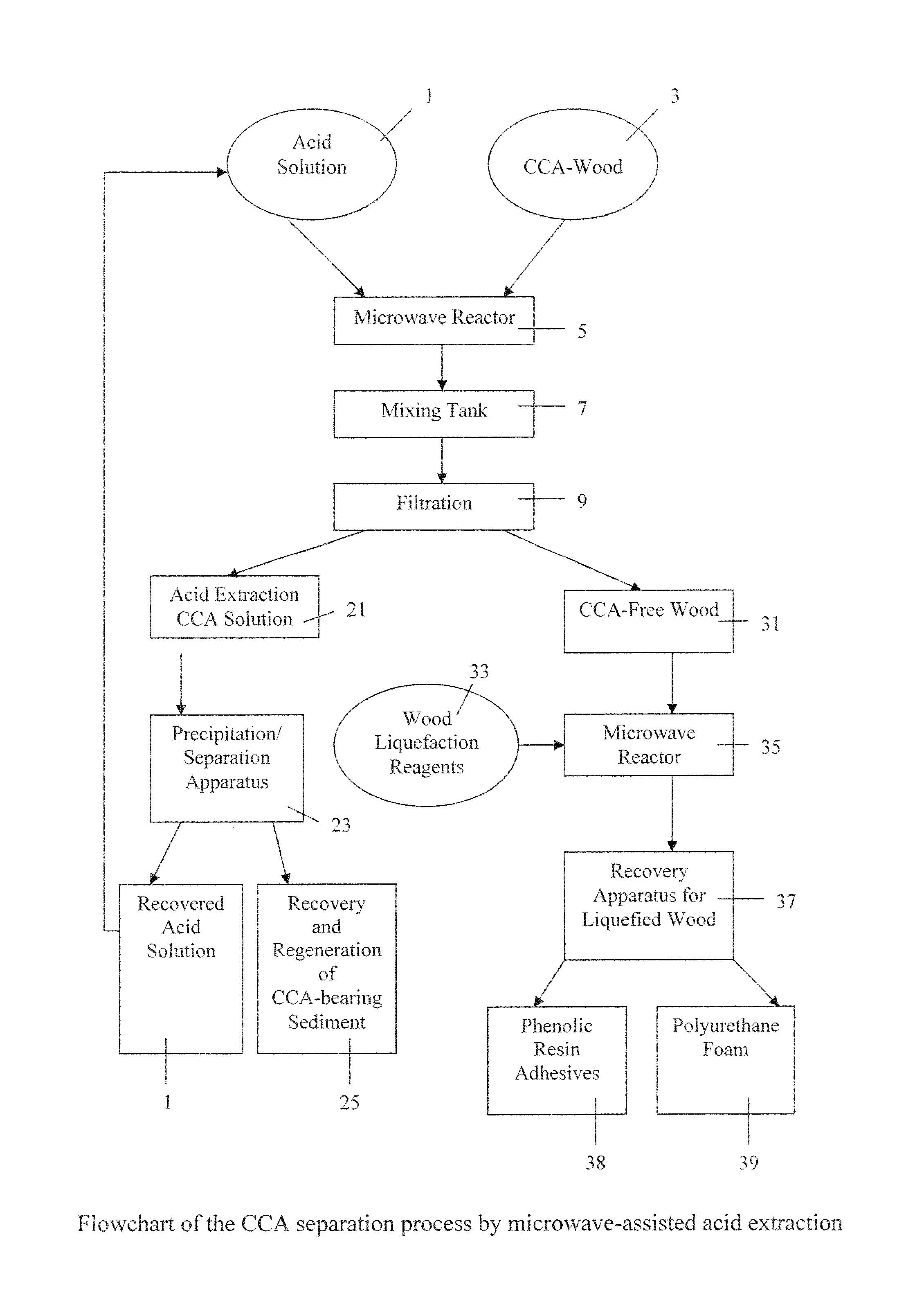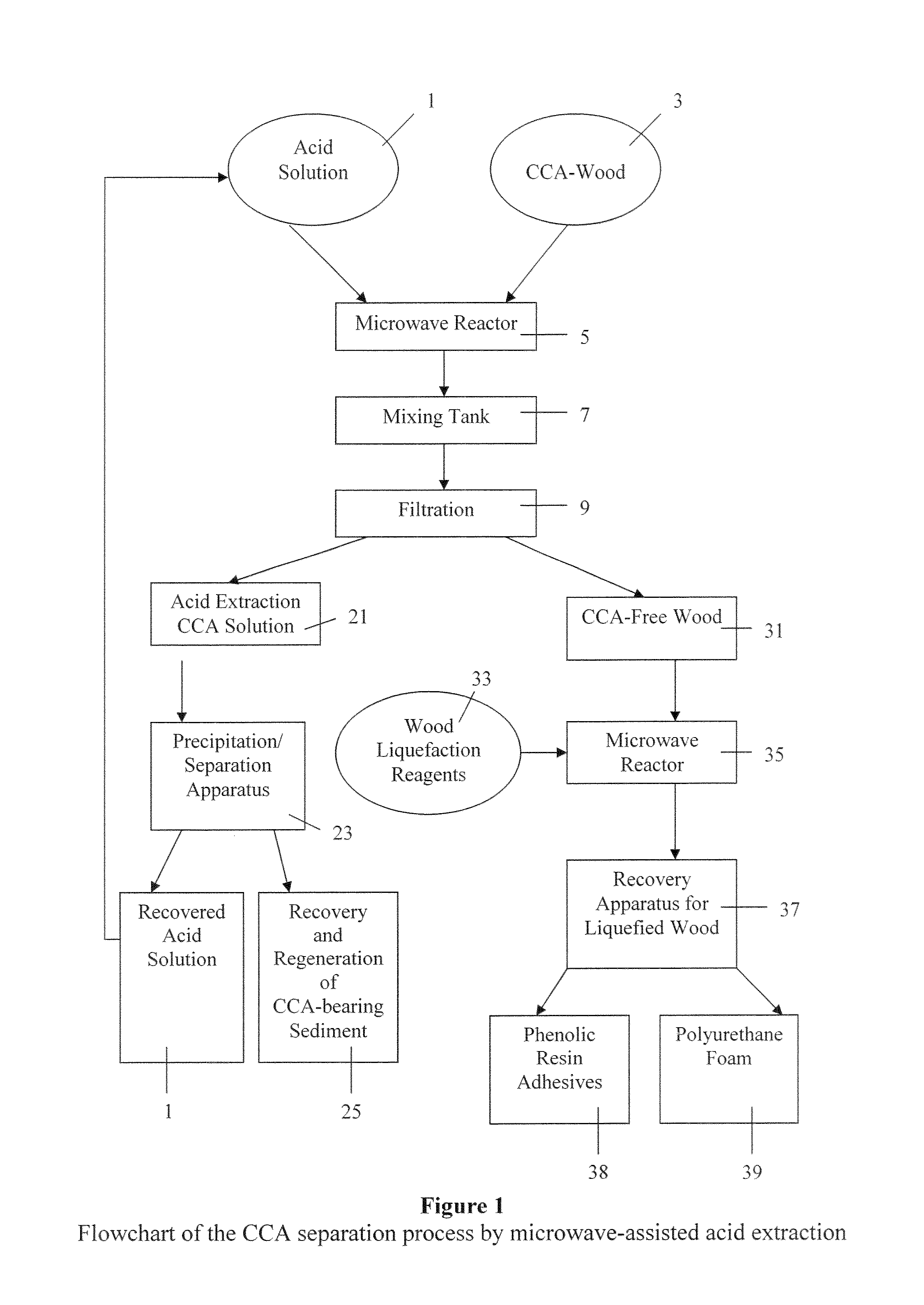Process for rapid microwave-enhanced detoxification of CCA-treated wood
- Summary
- Abstract
- Description
- Claims
- Application Information
AI Technical Summary
Benefits of technology
Problems solved by technology
Method used
Image
Examples
example 1
[0036]Wood chips from treated wood were dried at about 150° C. and then milled into sawdust. The dried sawdust was screened through a 40-mesh sieve. A dilute acid solution of oxalic acid, acetic acid, or phosphoric acid was mixed with the dried sawdust in a ratio of 1 g sawdust to 20 ml of dilute acid. The concentrations of the acids ranged from about 0.25% to about 1.00% by weight. The acid / sawdust mixture was then transferred to a 100 ml vessel, which was then sealed and placed in a microwave chamber (Milestone, Sheton, Conn.). The acid / sawdust mixture was heated by microwave radiation for approximately 30 minutes at approximately 160° C. The resulting material was then filtered, and the filtrate was diluted with sufficient water to raise the filtrate volume to 100 ml. The concentrations of each acid and their extraction efficiencies are shown in Table 1 below.
[0037]
TABLE 1CCA recovery rate in single acid of different concentration at 160° C. for 30 min.Acid Conc.As CrCuAcid(wt %)...
example 2
[0040]Wood chips from treated wood were prepared as described in paragraph [0036]. A mixture of acetic acid and oxalic acid was added to the dried sawdust in a ratio of 1 g of sawdust to 20 ml of the acid mixture. The concentrations of each acid and the ratio of acids are described below in Table 2. The acid / wood mixture was transferred to a 100 ml vessel, which was then sealed and placed in a microwave chamber (Milestone, Sheton. CT). The acid / wood mixture was heated by microwave radiation for approximately 30 minutes at approximately 160° C. The resulting material was filtered and the filtrate was diluted with sufficient water to raise the filtrate volume to 100 ml. Extraction efficiency is shown in Table 2 below.
[0041]
TABLE 2CCA recovery rate in different concentrations of mixed oxalic and acetic acid at 160° C. for 30 min.Acetic Oxalic Acid Conc.Acid Conc.As Cr Cu(wt %)(wt %)(% removed)(% removed)(% removed)1.51.099.6599.8834.571.01.099.6799.8932.930.51.099.5999.6531.501.50.599....
example 3
[0043]Wood chips from treated wood were prepared as described in paragraph [0036]. A mixture of phosphoric acid and either oxalic acid or acetic acid was added to the dried sawdust in a ratio of 1 g sawdust to 20 ml of the acid mixture. The concentrations of phosphoric acid ranged from about 0.5% to about 3.5% by weight. The concentration of oxalic acid or acetic acid was about 1% by weight. The acid / wood mixture was transferred to a 100 ml vessel, which was then sealed and placed in a microwave chamber (Milestone, Sheton, Conn.). The acid / wood mixture was heated by microwave radiation for approximately 30 minutes at approximately 160° C. The resulting material was filtered, and the filtrate was diluted with sufficient water to raise the filtrate volume to 100 ml. The extraction efficiencies are shown in Table 3 below.
[0044]
TABLE 3CCA recovery rate in different concentration of phosphoric acidwhen mixed with 1% oxalic or 1% acetic acid at 160° C. for 30 min.Phosphoric Oxalic / AceticA...
PUM
| Property | Measurement | Unit |
|---|---|---|
| Temperature | aaaaa | aaaaa |
| Temperature | aaaaa | aaaaa |
| Temperature | aaaaa | aaaaa |
Abstract
Description
Claims
Application Information
 Login to View More
Login to View More - R&D
- Intellectual Property
- Life Sciences
- Materials
- Tech Scout
- Unparalleled Data Quality
- Higher Quality Content
- 60% Fewer Hallucinations
Browse by: Latest US Patents, China's latest patents, Technical Efficacy Thesaurus, Application Domain, Technology Topic, Popular Technical Reports.
© 2025 PatSnap. All rights reserved.Legal|Privacy policy|Modern Slavery Act Transparency Statement|Sitemap|About US| Contact US: help@patsnap.com


